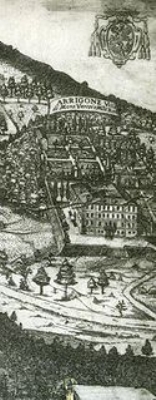
Villa Muti
Encyclopedia
Villa Muti is a rather plain appearing villa (from the outside) in Frascati
, Italy
, now in the communal territory of Grottaferrata
.

. Later the villa was modified by different owners including Cesarini and the Amadei.
The Muti family, who had obtained the property in the 1900s sold it at the end of World War II to the "Comune di Grottaferrata".
artists: Giovanni Lanfranco
(Meeting of Judah and Tamar, Joseph and his Brothers and Susanna Surprised While Bathing) and Pietro da Cortona
(Daniel in the Lion's Den and Story of Habbakuk). Frescoes of History of Agar are by the artist Ludovico Cigoli and of Moses on the Mount by Domenico Passignano
are in the first-floor rooms.
The villa has also elegant formal/English gardens of the villa with scenographic effects characterized by fantastic sculptures typical of Roman Mannerism
; it is structured on various levels of different historical stratification of landscape created around 1850.
Presently the villa is not open to the public and the gardens lack upkeep.
Frascati
Frascati is a town and comune in the province of Rome in the Lazio region of central Italy. It is located south-east of Rome, on the Alban Hills close to the ancient city of Tusculum. Frascati is closely associated with science, being the location of several international scientific...
, Italy
Italy
Italy , officially the Italian Republic languages]] under the European Charter for Regional or Minority Languages. In each of these, Italy's official name is as follows:;;;;;;;;), is a unitary parliamentary republic in South-Central Europe. To the north it borders France, Switzerland, Austria and...
, now in the communal territory of Grottaferrata
Grottaferrata
Grottaferrata, Italy is a small town and comune in the province of Rome, situated on the lower slopes of the Alban Hills, 20 km south east of Rome. It is bounded by other communes, Frascati, Rocca di Papa, Marino, and Rome.-History:...
.

History
Initial construction on the site was started in 1579 by Ludovico Cerasoli. The locale was then acquired in 1595 by the soon to be Cardinal, Pompeo Arrigoni and then divided into two parts and given to relatives including his nephew Cardinal Ciriaco RocciCiriaco Rocci
Ciriaco Rocci was an Italian Catholic Cardinal and papal nuncio to Switzerland, Austria and Cologne.Rocci was born in 1581 in Rome and studied literature before entering the service of the church....
. Later the villa was modified by different owners including Cesarini and the Amadei.
The Muti family, who had obtained the property in the 1900s sold it at the end of World War II to the "Comune di Grottaferrata".
Features
Inside there are frescoes by two major High BaroqueBaroque
The Baroque is a period and the style that used exaggerated motion and clear, easily interpreted detail to produce drama, tension, exuberance, and grandeur in sculpture, painting, literature, dance, and music...
artists: Giovanni Lanfranco
Giovanni Lanfranco
Giovanni Lanfranco was an Italian painter of the Baroque period.-Biography:Giovanni Gaspare Lanfranco was born in Parma, the third son of Stefano and Cornelia Lanfranchi, and was placed as a page in the household of Count Orazio Scotti...
(Meeting of Judah and Tamar, Joseph and his Brothers and Susanna Surprised While Bathing) and Pietro da Cortona
Pietro da Cortona
Pietro da Cortona, by the name of Pietro Berrettini, born Pietro Berrettini da Cortona, was the leading Italian Baroque painter of his time and also one of the key architects in the emergence of Roman Baroque architecture. He was also an important decorator...
(Daniel in the Lion's Den and Story of Habbakuk). Frescoes of History of Agar are by the artist Ludovico Cigoli and of Moses on the Mount by Domenico Passignano
Domenico Passignano
Domenico Passignano , born Cresti or Crespi, was an Italian painter of a late-Renaissance or Contra-Maniera style that emerged in Florence towards the end of the 16th century.- Biography :...
are in the first-floor rooms.
The villa has also elegant formal/English gardens of the villa with scenographic effects characterized by fantastic sculptures typical of Roman Mannerism
Mannerism
Mannerism is a period of European art that emerged from the later years of the Italian High Renaissance around 1520. It lasted until about 1580 in Italy, when a more Baroque style began to replace it, but Northern Mannerism continued into the early 17th century throughout much of Europe...
; it is structured on various levels of different historical stratification of landscape created around 1850.
Presently the villa is not open to the public and the gardens lack upkeep.
Sources
- Wells Clara Louisa - The Alban Hills, Vol. I: Frascati - 1878 publisher: Barbera, Rome, Italy - OCLC 21996251
- Villas of the Castelli Romani

